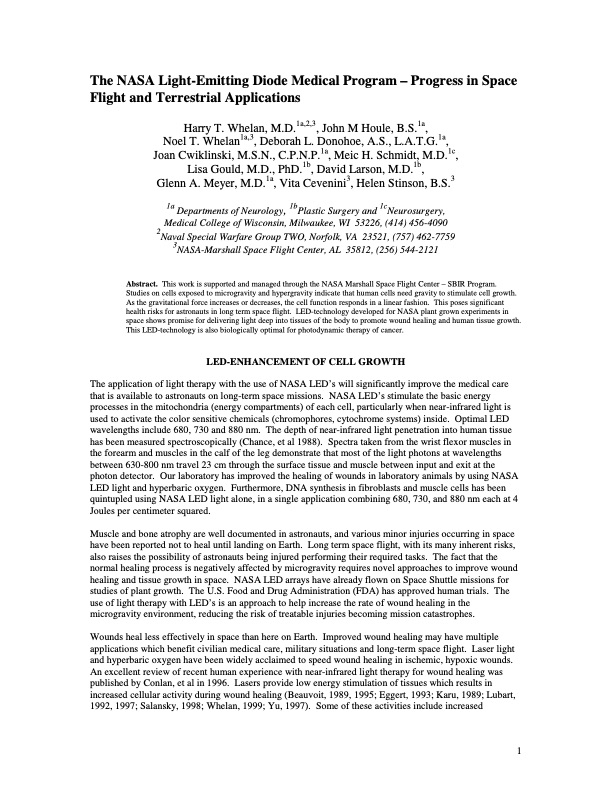
PDF Publication Title:
Text from PDF Page: 001
The NASA Light-Emitting Diode Medical Program – Progress in Space Flight and Terrestrial Applications Harry T. Whelan, M.D.1a,2,3, John M Houle, B.S.1a, Noel T. Whelan1a,3, Deborah L. Donohoe, A.S., L.A.T.G.1a, Joan Cwiklinski, M.S.N., C.P.N.P.1a, Meic H. Schmidt, M.D.1c, Lisa Gould, M.D., PhD.1b, David Larson, M.D.1b, Glenn A. Meyer, M.D.1a, Vita Cevenini3, Helen Stinson, B.S.3 1a Departments of Neurology, 1bPlastic Surgery and 1cNeurosurgery, Medical College of Wisconsin, Milwaukee, WI 53226, (414) 456-4090 2Naval Special Warfare Group TWO, Norfolk, VA 23521, (757) 462-7759 3NASA-Marshall Space Flight Center, AL 35812, (256) 544-2121 Abstract. This work is supported and managed through the NASA Marshall Space Flight Center – SBIR Program. Studies on cells exposed to microgravity and hypergravity indicate that human cells need gravity to stimulate cell growth. As the gravitational force increases or decreases, the cell function responds in a linear fashion. This poses significant health risks for astronauts in long term space flight. LED-technology developed for NASA plant grown experiments in space shows promise for delivering light deep into tissues of the body to promote wound healing and human tissue growth. This LED-technology is also biologically optimal for photodynamic therapy of cancer. LED-ENHANCEMENT OF CELL GROWTH The application of light therapy with the use of NASA LED’s will significantly improve the medical care that is available to astronauts on long-term space missions. NASA LED’s stimulate the basic energy processes in the mitochondria (energy compartments) of each cell, particularly when near-infrared light is used to activate the color sensitive chemicals (chromophores, cytochrome systems) inside. Optimal LED wavelengths include 680, 730 and 880 nm. The depth of near-infrared light penetration into human tissue has been measured spectroscopically (Chance, et al 1988). Spectra taken from the wrist flexor muscles in the forearm and muscles in the calf of the leg demonstrate that most of the light photons at wavelengths between 630-800 nm travel 23 cm through the surface tissue and muscle between input and exit at the photon detector. Our laboratory has improved the healing of wounds in laboratory animals by using NASA LED light and hyperbaric oxygen. Furthermore, DNA synthesis in fibroblasts and muscle cells has been quintupled using NASA LED light alone, in a single application combining 680, 730, and 880 nm each at 4 Joules per centimeter squared. Muscle and bone atrophy are well documented in astronauts, and various minor injuries occurring in space have been reported not to heal until landing on Earth. Long term space flight, with its many inherent risks, also raises the possibility of astronauts being injured performing their required tasks. The fact that the normal healing process is negatively affected by microgravity requires novel approaches to improve wound healing and tissue growth in space. NASA LED arrays have already flown on Space Shuttle missions for studies of plant growth. The U.S. Food and Drug Administration (FDA) has approved human trials. The use of light therapy with LED’s is an approach to help increase the rate of wound healing in the microgravity environment, reducing the risk of treatable injuries becoming mission catastrophes. Wounds heal less effectively in space than here on Earth. Improved wound healing may have multiple applications which benefit civilian medical care, military situations and long-term space flight. Laser light and hyperbaric oxygen have been widely acclaimed to speed wound healing in ischemic, hypoxic wounds. An excellent review of recent human experience with near-infrared light therapy for wound healing was published by Conlan, et al in 1996. Lasers provide low energy stimulation of tissues which results in increased cellular activity during wound healing (Beauvoit, 1989, 1995; Eggert, 1993; Karu, 1989; Lubart, 1992, 1997; Salansky, 1998; Whelan, 1999; Yu, 1997). Some of these activities include increased 1PDF Image | NASA Light-Emitting Diode Medical Program

PDF Search Title:
NASA Light-Emitting Diode Medical ProgramOriginal File Name Searched:
The_NASA_light-emitting_diode_medical_program-prog.pdfDIY PDF Search: Google It | Yahoo | Bing
Cruise Ship Reviews | Luxury Resort | Jet | Yacht | and Travel Tech More Info
Cruising Review Topics and Articles More Info
Software based on Filemaker for the travel industry More Info
The Burgenstock Resort: Reviews on CruisingReview website... More Info
Resort Reviews: World Class resorts... More Info
The Riffelalp Resort: Reviews on CruisingReview website... More Info
| CONTACT TEL: 608-238-6001 Email: greg@cruisingreview.com | RSS | AMP |